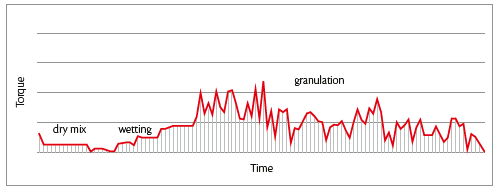
FMC chose IMA Active single-pot processor for its new plant in Ferentino, Italy.
From powder to granules: Roto Cube for nutraceuticals
Introduction
The manufacture of nutraceuticals can be challenging due to the different and variable physical properties of most of the natural ingredients and to the high content of active ingredients in formulations. More attention must be payed because of critical powder characteristics (particle size, flow, compressibility, moisture sensitivity). Quite often an intermediate step in manufacturing is needed to achieve final solid dosage forms (as capsules and tablets) with the required specifications. Nutraceutical manufacturers can take advantages in reducing production time and costs by using pharma-grade equipment, that allows to increase a consistent final product quality, ensure the proper potency and improve the product yield.
Wet granulation is one of the most significant operation in the production of OSD form suitable for nutraceutical preparations to convert difficult powders into free-flowing granules. In fact, granules increase the density and flowability of the bulk, so that it occupies less volume per dosage weight, useful to administer large dosage of active ingredients and facilitate volumetric dispensing. At the same time, they reduce dust all over the process and improve the appearance of the product especially if packed in sachets. Consequently, the ideal characteristics of granules include spherical shape for improved flow and sufficient percentage of fines to fill empty spaces between granules for better compaction (capsules), compression (tablets) and filling (sachets).
Among the currently available techniques, single-pot granulation is a very flexible one having a wide list of benefits:
- Granulation and drying into all in one unit.
- No more need to handle product between separate equipment for all process phases, reflecting in faster production time, increased final recovery yield and reduced man labor.
- Suitable for natural ingredients with variable physical properties, especially those which are moisture
or oxygen sensitive due to self-contained process where environmental exposure is minimized. - Easy and rapid to clean.
Single-pot processor is ideal for many different applications and products: conventional wet granulation and drying, melt granulation, pelletization, effervescent formulation.
From powder to granules: Roto Cube for nutraceuticals
Milk Thistle (Silybum marianum) is an herb with medical properties. Its seeds contain silymarin, a group of compounds known for antioxidant and anti-inflammatory properties. It is mostly used as a home remedy to protect liver, especially when on overload; the herb is also believed to prevent or sustain therapies for high cholesterol, diabetes, heartburn, upset stomach (dyspepsia), hangover, gallbladder problems, menstrual pain, depression, and even certain types of cancer. Milk Thistle granules are made 100% of active natural ingredient (Milk Thistle dry extract, MTE) and commonly marketed in capsule form but are also available as tablets.
MTE is a powder with extremely fine and irregular-shaped particles having poor flowability reflecting in difficult handling to hard capsules or compressed tablets. Granulation of MTE in Roto Cube single-pot processor allows an improved flow by using only water as granulating liquid, without the need to use any binder or other excipients in the formulation. The free-flowing agglomerates are sphere-like shaped resulting from the combined effect of high impeller speed and shear managed by massing time.
A smooth proven granulation procedure for manufacturing for MTE granules has been developed by FMC with IMA Active Laboratory support. MTE raw powder is loaded in containment with no dust generation in the room by means of vacuum into the Roto Cube bowl. Pure water is rapidly sprayed by means of a peristaltic pump on to the powder while mixing. MTE is poor soluble in water but once wet self-binding properties. In combination with the Roto Cube’s impeller high-shear to the mass particles becomes plastic enough to generate sphere-like agglomerates.
Water amount varies depending on the raw material provision. Water amount can be automatically managed by Roto Cube control system by controlling impeller torque change (Figure 1).

Figure 1: impeller torque change.
Once the granules are obtained, drying phase can begin. The jacketed process bowl is heated and put under vacuum to promote water evaporation.
Impeller speed is then reduced at minimum to gently move the granules so to promote heat transfer between the heated process bowl and the bulk mass (Figure 2).

Figure 2: product, vapor and jacked temperatures during processing.
The drying end-point is achieved when residual moisture content (LOD) goes back to the same of the raw material MTE. The dried granules are subsequently unloaded and sized using a conical mill that’s integrated into the Roto Cube discharge valve. Characterization of the sized MTE granules shows the improving in both density and flowability compared to the starting raw powder.
In conclusion, MTE single-pot granulation in Roto Cube allows a fast and highly reproducible process also beneficial to overcome the issue of powder variability thanks to its control system with impeller torque monitoring. No more weight variations are to expect on high-speed encapsulation or tablet press machines.
| Characterization | MTE raw material (%) | MTE milled granules (%) |
| Bulk density (g/ml) – starting volume 100 ml | 0.47 -0.53 | 0.60 – 0.65 |
| Tapped density (g/ml) – after 1,250 strokes | 0.66 – 0.67 | 0.73 – 0.75 |
| ICarr (%) – Flowability Index | 21-29 (poor flowability) | 7-9 (excellent flowability) |
Table 1: chracterisation of the sized MTE granules.


